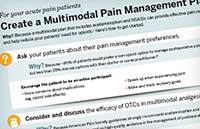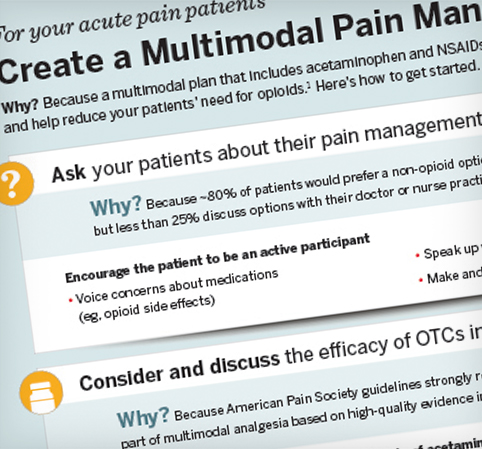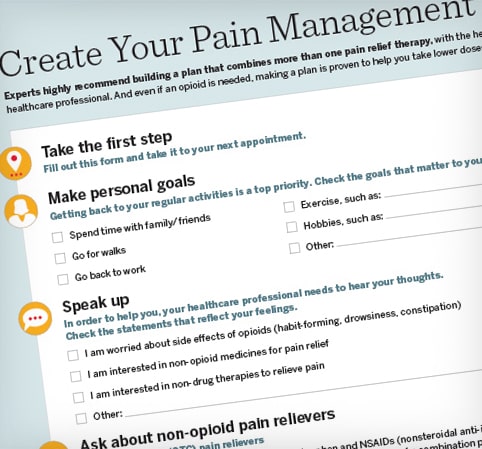Multimodal Analgesia
Every day you work to provide relief for your patients’ pain while managing risks. Balancing the risks and benefits of all pain treatment options can be challenging, especially when managing pain after surgery.
Help patients managing pain with a multimodal plan
In a 2018 Mayo Clinic survey, 94% of adults surveyed said they would choose an alternative to opioids for treatment after surgery, but only 25% have talked to their healthcare professional about such alternatives.1*
Support your patients with a personalized, multimodal pain management plan that can include multiple medications and techniques, including opioid, non-opioid (prescription or OTCs), and topical medications, as well as nonpharmacologic therapies.

Download this guide
Keep multimodal analgesia reminders on hand when creating pain management plans with your patients.
Involve your patients to make their pain plan
An individualized, patient- and family-centered plan that’s unique to each patient is recommended.2 Help patients become active participants in their pain plans by discussing their personal recovery goals and treatment concerns.
-
Ask your patients about their pain management preferences. Many patients want to learn more about all of their pain treatment options but are not discussing them with their healthcare professional.1
-
Communicate clearly and concisely. Patients may feel overwhelmed or forget to ask important questions about how to manage pain.
-
Give them this simple, easy-to-use planner before surgery. They can even fill it out at home or in your waiting room before a pre-surgery appointment.
-
Personalize their plan. Each patient has different recovery goals and interest in different therapies for pain after surgery. Consider personal health conditions and gauge interest in alternative pain treatment options.
Alternative pain management therapies, including physical modalities, may also be used. Patients may benefit from pain management techniques such as3,4:
-
Transcutaneous electrical nerve stimulation (TENS)
-
Cold and heat therapy
-
Acupuncture
-
Massage
Consider and discuss the efficacy and safe use of OTCs with patients
When you recommend an OTC analgesic as part of a patient’s pain management plan, remind them to:
-
Follow your recommendation exactly. Patients may stop their analgesic treatment regimen if they feel their pain is under control. Encourage them to follow your dosing directions to stay ahead of their pain.
-
Define personal goals. Explain that eliminating pain completely may not be achievable and work together to create realistic, meaningful goals that can help patients get back to normal functioning.
-
Keep you informed on their progress. Revisit your patients’ pain and function levels, and adjust their post-surgery pain management regimen accordingly.
-
Use OTC pain medicine safely. Provide handouts with OTC analgesic dosage and frequency. Help your patients make an appropriate choice by asking about other medications they may be taking, and remind them to take ONLY 1 medicine that contains the same kind of active ingredient at a time.
-
Reinforce OTC analgesic efficacy. Numerous studies support the efficacy of OTC analgesics for a variety of pain states.5-10 A 2019 US Department of Health and Human Services report recommends multimodal regimens that include non-opioid medications, such as acetaminophen or NSAIDs, for perioperative pain.11
Multimodal Pain Management Guide
Keep multimodal analgesia reminders on hand when creating pain management plans.
Help patients define pain relief goals
Download a pain management planner for your patients.
*Based on Mayo Clinic National Health Checkup Survey of 1,270 adults (18 years and older) living in the US conducted in July 2018 through Engine Telephone CARAVAN Omnibus Survey.
REFERENCES: 1. Kehren HC. Mayo Clinic National Health Checkup: Most Americans would choose an alternative to opioids following surgery. Mayo Clinic website. https://newsnetwork.mayoclinic.org/discussion/mayo-clinic-national-health-checkup-most-americans-would-choose-an-alternative-to-opioids-following-surgery/. Published October 23, 2018. Accessed August 29, 2019. 2. Advancing the Safety of Acute Pain Management. Boston, Massachusetts: Institute for Healthcare Improvement; 2019. Available on ihi.org. 3. Wu MS, Chen KH, Chen IF, et al. The efficacy of acupuncture in post-operative pain management: a systematic review and meta-analysis. PLoS One. 2016;11(3):e0150367. 4. Kukimoto Y, Ooe N, Ideguchi N. The effects of massage therapy on pain and anxiety after surgery: a systematic review and meta-analysis. Pain Manag Nurs. 2017;18(6):378-390. 5. Milsom I, Minic M, Dawood MY, et al. Comparison of the efficacy and safety of nonprescription doses of naproxen and naproxen sodium with ibuprofen, acetaminophen, and placebo in the treatment of primary dysmenorrhea: a pooled analysis of five studies. Clin Ther. 2002;24(9):1384-1400. 6. Moore RA, Derry C. Efficacy of OTC analgesics. Int J Clin Pract Suppl. 2013;(178):21-25. 7. Patel S, McGorray SP, Yezierski R, Fillingim R, Logan H, Wheeler TT. Effects of analgesics on orthodontic pain. Am J Orthod Dentofacial Orthop. 2011;139(1):e53-e58. 8. Schug SA, Sidebotham DA, McGuinnety M, Thomas J, Fox L. Acetaminophen as an adjunct to morphine by patient-controlled analgesia in the management of acute postoperative pain. Anesth Analg. 1998;87(2):368-372. 9. Stockler M, Vardy J, Pillai A, Warr D. Acetaminophen (paracetamol) improves pain and well-being in people with advanced cancer already receiving a strong opioid regimen: a randomized, double-blind, placebo-controlled cross-over trial. J Clin Oncol. 2004;22(16):3389-3394. 10. Varner J, Lomax M, Blum D, Quessy S. A randomized, controlled, dose-ranging study investigating single doses of GW406381, naproxen sodium, or placebo in patients with acute pain after third molar tooth extraction. Clin J Pain. 2009;25(7):577-583. 11. US Department of Health and Human Services. Draft report on pain management best practices: updates, gaps, inconsistencies, and recommendations. https://www.hhs.gov/ash/advisory-committees/pain/reports/2018-12-draft-report-on-updates-gaps-inconsistencies-recommendations/index.html#. Accessed November 26, 2019.



